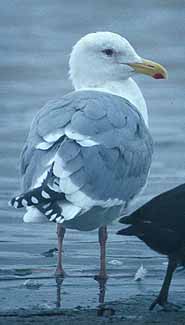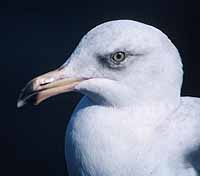MISIDENTIFICATION #3: "HERRING GULLS"

 Whenever I happen to see field notes or a boat trip list from eastern or
mid-western birders who are on their first visit to the Monterey Peninsula,
I often find that they have recorded the presence of "Herring Gulls" at
Pt. Pinos or on Monterey Bay, often in some numbers. Most glaringly, one
finds this species listed in September or early October. While Herring
Gulls are present at these locales in small numbers in winter, they are
essentially absent before late October. What these out-of-state observers
noted was
variation in Western Gulls (both photos), either some
pale-backed birds (first photo; an adult) among darker-backed individuals,
or very pale-eyed individuals (second photo; a third-winter bird). The
Monterey Peninsula attracts very dark-backed wymani Western Gulls
from southern California, and very pale-backed nominate occidentalis
from Oregon & Washington. Our local nesters are somewhere in between.
The first photo is about the palest bird I've ever seen, and it may actually
show introgression with Glaucous-winged Gull, but the head is unmarked
in February and the wingtips look very blackish, suggesting an extremely
pale-backed Western. Eye color is extremely variable in Western Gull (contra
some literature). In all cases, notice the short, thick, bulbous-tipped
bill so characteristic of Western Gull. The gonydeal angle is particularly
pronounced. Out-of-staters often just assume that Herring Gull is as widespread
here as it is in the East, and therefore don't pay much attention, but
Herring Gull is quite local in Monterey County.
Whenever I happen to see field notes or a boat trip list from eastern or
mid-western birders who are on their first visit to the Monterey Peninsula,
I often find that they have recorded the presence of "Herring Gulls" at
Pt. Pinos or on Monterey Bay, often in some numbers. Most glaringly, one
finds this species listed in September or early October. While Herring
Gulls are present at these locales in small numbers in winter, they are
essentially absent before late October. What these out-of-state observers
noted was
variation in Western Gulls (both photos), either some
pale-backed birds (first photo; an adult) among darker-backed individuals,
or very pale-eyed individuals (second photo; a third-winter bird). The
Monterey Peninsula attracts very dark-backed wymani Western Gulls
from southern California, and very pale-backed nominate occidentalis
from Oregon & Washington. Our local nesters are somewhere in between.
The first photo is about the palest bird I've ever seen, and it may actually
show introgression with Glaucous-winged Gull, but the head is unmarked
in February and the wingtips look very blackish, suggesting an extremely
pale-backed Western. Eye color is extremely variable in Western Gull (contra
some literature). In all cases, notice the short, thick, bulbous-tipped
bill so characteristic of Western Gull. The gonydeal angle is particularly
pronounced. Out-of-staters often just assume that Herring Gull is as widespread
here as it is in the East, and therefore don't pay much attention, but
Herring Gull is quite local in Monterey County.

To the right is a flight shot of a real Herring Gull offshore
(third-winter plumage with tail band). Note the big but long bill
without much gonydeal angle, the "fierce" or "mean" look to the head, and
the pale gray back, in addition to the pale eye. Also the head is heavily
streaked in winter, while all adult Western Gulls remain white-headed
throughout winter (in my opinion, any streaking on the head of an adult
Western in winter is either evidence of (a) young age, maybe just barely
4th year, or (b) introgression with Glaucous-winged; this opinion is contra
published works on gulls).
Western Gulls are common throughout the year along the shores of Monterey
Bay (esp. rocky shores) and down the Big Sur coast, although migrants from
northern and southern populations are here primarily in Oct-March. They
are very rare inland (only a handful of records at the Salinas wastewater
ponds, only 7 miles upstream from the coast). The distribution of Herring
Gulls is quite different. They are common at two local roosts (in Moss
Landing harbor and at the Little Sur R. mouth) but must less common along
the rest of the coastline (regular, but at smaller numbers, at the gull
roosts at Salinas and Pajaro R. mouths, scarcer still at Pt. Pinos and
Carmel R. mouth). Good numbers vist the Marina dump. But they are most
common well offshore -- farther offshore than most Monterey Bay boat trips.
Pelagic trips in Monterey Bay from October into May will have a few Herring
Gulls, but one must get 30-50 miles offshore before they are the dominant
gull, and then they are often the only larger gull present in the 50-100
mile offshore zone.
PHOTOS: The adult light-backed Western
Gull
was at Roberts Lake, Seaside, Monterey Co., on 22 Jan 1999;
the pale-eyed Western Gull was in the Monterey
harbor on 25 Feb 1998. The flight shot of 3rd-winter Herring
Gull was near the Davidson Seamount, Monterey Co. (60 miles offshore),
on 17 Nov 1979. All photos © D. Roberson.
TOP
BACK TO
TEN MOST MISIDENTIFIED PAGE
GO TO
IDENTIFICATION PAGE
GO TO HOME PAGE
GO TO LIST OF BIRD
FAMILIES OF THE WORLD

 Whenever I happen to see field notes or a boat trip list from eastern or
mid-western birders who are on their first visit to the Monterey Peninsula,
I often find that they have recorded the presence of "Herring Gulls" at
Pt. Pinos or on Monterey Bay, often in some numbers. Most glaringly, one
finds this species listed in September or early October. While Herring
Gulls are present at these locales in small numbers in winter, they are
essentially absent before late October. What these out-of-state observers
noted was
variation in Western Gulls (both photos), either some
pale-backed birds (first photo; an adult) among darker-backed individuals,
or very pale-eyed individuals (second photo; a third-winter bird). The
Monterey Peninsula attracts very dark-backed wymani Western Gulls
from southern California, and very pale-backed nominate occidentalis
from Oregon & Washington. Our local nesters are somewhere in between.
The first photo is about the palest bird I've ever seen, and it may actually
show introgression with Glaucous-winged Gull, but the head is unmarked
in February and the wingtips look very blackish, suggesting an extremely
pale-backed Western. Eye color is extremely variable in Western Gull (contra
some literature). In all cases, notice the short, thick, bulbous-tipped
bill so characteristic of Western Gull. The gonydeal angle is particularly
pronounced. Out-of-staters often just assume that Herring Gull is as widespread
here as it is in the East, and therefore don't pay much attention, but
Herring Gull is quite local in Monterey County.
Whenever I happen to see field notes or a boat trip list from eastern or
mid-western birders who are on their first visit to the Monterey Peninsula,
I often find that they have recorded the presence of "Herring Gulls" at
Pt. Pinos or on Monterey Bay, often in some numbers. Most glaringly, one
finds this species listed in September or early October. While Herring
Gulls are present at these locales in small numbers in winter, they are
essentially absent before late October. What these out-of-state observers
noted was
variation in Western Gulls (both photos), either some
pale-backed birds (first photo; an adult) among darker-backed individuals,
or very pale-eyed individuals (second photo; a third-winter bird). The
Monterey Peninsula attracts very dark-backed wymani Western Gulls
from southern California, and very pale-backed nominate occidentalis
from Oregon & Washington. Our local nesters are somewhere in between.
The first photo is about the palest bird I've ever seen, and it may actually
show introgression with Glaucous-winged Gull, but the head is unmarked
in February and the wingtips look very blackish, suggesting an extremely
pale-backed Western. Eye color is extremely variable in Western Gull (contra
some literature). In all cases, notice the short, thick, bulbous-tipped
bill so characteristic of Western Gull. The gonydeal angle is particularly
pronounced. Out-of-staters often just assume that Herring Gull is as widespread
here as it is in the East, and therefore don't pay much attention, but
Herring Gull is quite local in Monterey County.
